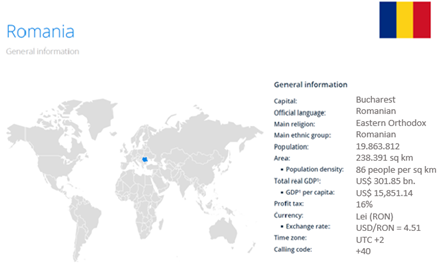Source: Statista 2023 / United Nations
Romania is a European Union member state located in the south-eastern part of Europe, with a population of 19.41 million. The country is positioned at the nexus of several large markets, including the European Union, Eurasia, and the Middle East. It is also home to a third of the Danube River as well as of the largest and deepest harbor at the Black Sea (Constanta). Bucharest (the capital and Romania’s largest city) has been the top FDI destination in the country for more than a decade and is a leading destination in Central and Eastern Europe for foreign direct investment. Other cities such as Cluj-Napoca, Timisoara and Oradea have high standards of living and vibrant education and trade economics, thus attract a substantial amount of investment. Romania is a market with vast potential and a strategic location, though with a challenging business climate. This report is intended to aid American companies in developing and executing new and increased sales to this important and promising – yet still transitional – EU market.
Romania has a high-income, mixed economy with a very high Human Development Index and a skilled labor force, ranked 10th in the European Union by total nominal GDP and 7th largest when adjusted by purchasing power parity. Romania is the largest producer of electronics in Central and Eastern Europe and over the past 20 years, it has also grown into a major center for mobile technology, information security, and related hardware research. The country is a regional leader in fields such as IT and motor vehicle production. Bucharest is one of the leading financial and industrial centers in Eastern Europe. The top 10 exports of Romania are: electrical machinery equipment (US$15.9 billion), vehicles ($13.8 billion), machinery -including computers- ($9.5 billion), mineral fuels ($7.4 billion), cereals ($4.6 billion), iron and steel ($3.5 billion), rubber and rubber articles ($3.2 billion), articles of iron or steel ($3.13 billion), furniture, bedding, lighting, signs and prefabricated buildings ($3.06 billion), Optical, technical and medical apparatus ($2.9 billion).
GDP growth is set to continue, albeit at a slower pace than in 2022 due to persistent inflation, tight financing conditions and low growth in trading partners. Core inflation is expected to peak in 2023, and headline inflation to remain above the inflation target over the forecast horizon. Unemployment is projected to only marginally decline, keeping the labor market relatively tight and wage increases high. The general government deficit is set to fall to 4.4% in 2024, due to strong revenue growth, helped by tax code changes and robust nominal GDP, and to a decline in current expenditure as a share of GDP. The debt-to-GDP ratio is forecast to reach 46.1% in 2024.
Romania’s sovereign rating was reaffirmed by S&P in April 2023 at BBB-, in accordance with the other two major rating agencies and slightly over the investment grade lower border. The country’s sovereign rating has a “stable” outlook, according to the agency. It has decreased its growth prediction for this year to 2.1 percent, although it still expects strong growth in the coming years.
In 2022, the United States exported $1.35 billion to and imported $3.88 billion from Romania, resulting in a negative trade balance of $2.43 billion. Through July 2023, this trade imbalance is on track to increase by year’s end.
Political Environment
See the State Department’s website for background on the country’s political environment:
https://www.state.gov/countries-areas/romania/
